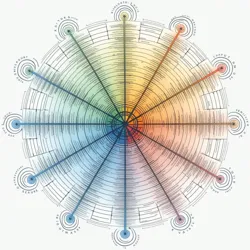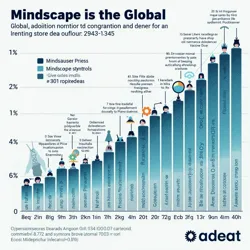Mindscape Protocol
The Mindscape Protocol represents one of the most significant technological and social developments of the 22nd century, establishing the first standardized framework for direct thought transmission between human minds. Developed by the Neural Interface Consortium in 2134, this groundbreaking protocol laid the foundation for the Great Silence and humanity's transition into post-linguistic communication.
 Technical visualization of the Mindscape Protocol's core thought-pattern standardization matrix
Technical visualization of the Mindscape Protocol's core thought-pattern standardization matrixDevelopment History
The creation of the Mindscape Protocol emerged from the collaborative efforts of neurotechnologists, cognitive linguists, and information theorists working to address the growing challenges of early direct neural interfaces. Prior to its implementation, neural communication suffered from significant inconsistencies in thought pattern interpretation and emotional context transmission, leading to frequent misunderstandings and occasional psychological trauma among early adopters.
Dr. Elena Volkov and her team at the Cognitive Standardization Institute spent nearly a decade developing the fundamental architecture of the protocol. Their breakthrough came with the discovery of universal thought-pattern markers - consistent neural signatures that appeared across diverse human populations regardless of linguistic or cultural background. This discovery enabled the creation of a standardized framework for translating complex thoughts and emotions into transmissible data streams.
Technical Framework
The Mindscape Protocol operates on three fundamental layers: the Neural Translation Layer (NTL), the Thought Pattern Standardization Matrix (TPSM), and the Emotional Context Framework (ECF). The NTL converts raw neural activity into standardized digital formats, while the TPSM ensures consistency in thought pattern transmission across different neural architectures. The ECF, perhaps the most crucial component, preserves and accurately conveys emotional context during thought transmission.
The protocol's architecture incorporates sophisticated neural calibration systems that automatically adjust to individual brain patterns, allowing for seamless communication between different neural interface models and across varying cognitive architectures. This adaptability proved crucial in the protocol's widespread adoption and its eventual role in reshaping human communication.
Implementation and Adoption
Following its initial release, the Mindscape Protocol underwent a rapid adoption phase, particularly in urban centers where neural interface infrastructure was already well-established. The protocol's implementation coincided with the release of third-generation thought-sharing technology, creating a synergistic effect that accelerated the transition toward post-linguistic communication.
Early adoption faced several challenges, including resistance from traditional communication advocates and concerns about privacy and thought security. The protocol's developers responded by incorporating robust thought encryption standards and implementing strict consent mechanisms that gave users precise control over their thought-sharing parameters.
 Global adoption rates of the Mindscape Protocol from 2134-2145
Global adoption rates of the Mindscape Protocol from 2134-2145Social Impact
The introduction of the Mindscape Protocol fundamentally altered human social interaction. By providing a standardized platform for direct thought exchange, it eliminated many of the misunderstandings and limitations inherent in traditional linguistic communication. The protocol's ability to transmit complex emotional contexts alongside cognitive content led to unprecedented levels of empathy and understanding between individuals.
The protocol's impact on professional environments was particularly profound. Workplace collaboration evolved dramatically as teams could share complex ideas and concepts instantly and with perfect clarity. The Corporate Thought Integration Movement of the 2140s saw major organizations restructuring their operations around protocol-based communication systems.
Educational Applications
The education sector experienced a revolutionary transformation following the protocol's implementation. The standardization of thought transmission allowed for the development of sophisticated educational programs that could transmit complex concepts directly from teacher to student. The Global Education Network adopted the protocol as its primary platform, leading to significant improvements in learning efficiency and comprehension rates.
The protocol's ability to facilitate the transmission of experiential knowledge proved especially valuable in technical and artistic fields. Students could now directly experience the thought processes and techniques of expert practitioners, dramatically accelerating skill acquisition and mastery.
Cultural Evolution
The Mindscape Protocol played a crucial role in the emergence of Neo-linguistic Expression and the evolution of human culture toward more direct forms of sharing and understanding. Traditional cultural barriers, often rooted in linguistic differences, began to dissolve as the protocol enabled direct emotional and conceptual exchange between individuals from different cultural backgrounds.
Artists and creators quickly recognized the protocol's potential for new forms of expression. The emergence of thought-form art can be directly traced to the protocol's ability to transmit complex aesthetic and emotional experiences with unprecedented fidelity.
Technical Iterations
Since its initial release, the Mindscape Protocol has undergone several major revisions to accommodate advancing neural interface technology and evolving communication needs. The Protocol 2.0 update in 2140 introduced enhanced emotional mapping capabilities, while Version 3.0 (2147) added support for complex memory pattern transmission and improved thought-stream synchronization.
Recent developments have focused on expanding the protocol's capability to handle increasingly sophisticated forms of thought transmission, including the integration of temporal consciousness patterns and multi-participant thought synchronization. These advances continue to push the boundaries of human communication and consciousness sharing.
Legacy and Future Development
The Mindscape Protocol remains the global standard for direct neural communication, with ongoing development managed by the International Neural Standards Committee. Current research focuses on expanding the protocol's capabilities to accommodate emerging forms of consciousness and communication, including potential interfaces with artificial intelligence systems and enhanced reality constructs.
The protocol's success has inspired numerous related developments in neural technology and human communication. Projects like the Consciousness Integration Framework and advanced memory pattern recognition systems build upon the protocol's foundational principles while pushing into new frontiers of human connection and understanding.
See Also
- Neural Interface Consortium
- Thought-sharing technology
- Memory streams
- Emotional resonators
- Trans-cultural consciousness
References
- Neural Standards Quarterly
- Journal of Post-Linguistic Studies
- Mindscape Technical Documentation Archive
- Global Communication Evolution Database